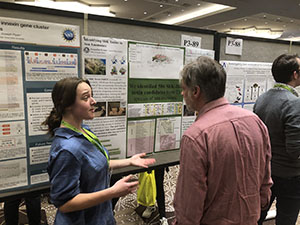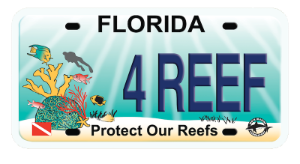
FSC Marine Biology Students Participate in an International Conference
Jan 23, 2020

Students conducting research with Marine Biology professor Dr. Jason Macrander had the opportunity to participate in their first ever international conference at the Society of Integrative and Comparative Biology (SICB) meeting, which took place in Austin, Texas from January 3rd to January 7th.
Not only did the four attending students present their research there, but they also worked with other researchers who have been published in the society’s associated journals, Integrative Organismal Biology and Integrative and Comparative Biology.
Students worked on various marine biology research that incorporated studies on sea anemone toxin evolution, the impacts of microplastics on differential gene expression, and contrasting thermal stress response in sea anemones hosting or lacking zooxanthellae symbionts.
Sea Anemone Toxins
Biotechnology major Jackie Krantz ‘20 presented her honors research on the evolution of a sea anemone toxin, ShK, a venomous protein that is currently being treated to fight multiple sclerosis. Jackie’s research aims to identify similar toxins in other species and evaluate them for their pharmaceutical potential. Her research identified hundreds of new candidate toxins from over two dozen species of sea anemone.

“Toxins and other naturally derived products synthesized for predatory defense or prey capture can often be harmful to humans, but in some cases they may also present pharmaceutical potential,” Krantz said. “The ShK toxin has been isolated from the sea anemone Stichodactyla helianthus and is currently being tested to treat multiple sclerosis in humans.”
Toxins containing this domain are ubiquitous across sea anemones as they target potassium ion channels, potentially being used to immobilize prey or deter predators.
“We hypothesized that there may be variations of the toxin that are naturally produced by other species that may serve as better pharmaceuticals to combat other neurodegenerative or autoimmune diseases,” Krantz said. “Our bioinformatic approach has found hundreds of other ShK toxins in other sea anemone species and tested hypotheses regarding ShK evolution by identifying homologous or convergent ShK products. Our results are the first step towards identifying toxin candidates similar to ShK proteins that could combat various types of autoimmune or even neurological diseases.”
Elevated Temperature Stress
Marine Biology major Serena Manzi ‘20 presented her research on elevated temperature stress in the sea anemone Exaiptasia pallida. Serena’s research is funded by a “Protect our Reefs” grant through Mote Marine Laboratory.

This sea anemone hosts the same strain of symbiont found in many coral species and has emerged as a laboratory model for studying coral bleaching. Her research contrasted differences in stress responses of this symbiont hosting anemone with Diadumene lineata, a species that completely lacks symbionts.
“Climate change has become the biggest issue humans have had to face yet,” Manzi said. “Above all the other impacts that climate change has had on the natural world, most notably is its decimation of coral reef ecosystems. With heat waves at new intensities, corals are bleaching at alarming rates, causing whole ecosystems to collapse and a loss of most reefs around the world. Scientists have been studying the effects of climate change and how to possibly combat it, using sea anemone models that have similar relationships with zooxanthellae.”

The sea anemone species, Exaiptasia pallida, has emerged as a laboratory model for studying corals’ associations with the zooxanthellae and its associated stress response with the coral body in elevated water temperatures. The focus of the study was to highlight comparisons of differential gene expression between E.pallida and D.lineata, another species of sea anemone that does not have zooxanthellae.
Through the analysis, it was found that neither anemone present any heat shock proteins, which was different from expected. However, they did show stress through observation and in other increased stress related proteins.
Gene Expression in the Naturally Occurring Relationships
Marine Biology major Shayna Burg ‘20 is currently conducting research under the guidance of Dr. Macrander, specifically to look at the interactions between clownfish and sea anemones.
Her research aims to determine how the presence of a symbiotic clownfish influences the sea anemone from a combined behavioral and genetic perspective. She attended the conference and sought to use it as a networking opportunity for future graduate school programs.
“I would recommend that any student, doing research or not, attend,” Burg said. “Networking is one of the most important aspects to introducing yourself to the scientific community and there isn’t a better place to do so than at SICB. I met undergraduate and graduate students, postdocs, and current professors from around the country and learned about many new topics. Going to this conference gave me better insights that will help me decide my future plans for graduate school and topics that I want to continue my research on.”

Microplastics and Ocean Impacts
Marine Biology major Andrea Frias ‘22 presented her research on the impact of microplastics on survivorship, behavior, and physiology as it relates to venom expression in estuarine sea anemone Nematostella vectensis.
Andrea’s research found that when exposed to elevated temperature and microplastics, the sea anemones were negatively impacted with an increased stress response and overall lower venom expression.
Microplastics are an ever growing problem in the ocean and her results indicate that other ocean life that rely on venom for survival (jellyfish, corals, and others) may be subjected to higher predation and reduced prey capture, which in turn could result in the decline of the species.
Being only a sophomore, Frias was really impressed by the opportunity she was exposed to so early in her undergraduate college career. “I feared I would feel like a little fish in a big pond, but this was not the case. Everyone I encountered at SICB was incredibly friendly and supportive regardless of background or title. I am thankful for the friends, mentors, connections, and experiences that the conference has provided me, and for the doors that I know have the keys to open.